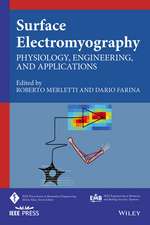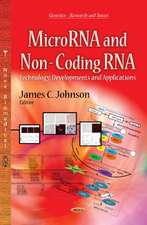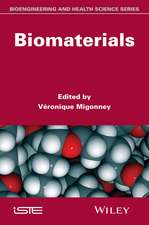Analytical Applications of Immobilized Enzyme Reactors
Editat de S. Lam, G. Malikinen Limba Engleză Paperback – 30 oct 2012
| Toate formatele și edițiile | Preț | Express |
|---|---|---|
| Paperback (1) | 1216.65 lei 43-57 zile | |
| SPRINGER NETHERLANDS – 30 oct 2012 | 1216.65 lei 43-57 zile | |
| Hardback (1) | 1225.94 lei 43-57 zile | |
| SPRINGER NETHERLANDS – 30 sep 1994 | 1225.94 lei 43-57 zile |
Preț: 1216.65 lei
Preț vechi: 1483.71 lei
-18% Nou
Puncte Express: 1825
Preț estimativ în valută:
232.80€ • 243.72$ • 192.63£
232.80€ • 243.72$ • 192.63£
Carte tipărită la comandă
Livrare economică 07-21 aprilie
Preluare comenzi: 021 569.72.76
Specificații
ISBN-13: 9789401045711
ISBN-10: 9401045712
Pagini: 292
Ilustrații: XII, 276 p.
Dimensiuni: 155 x 235 x 15 mm
Greutate: 0.41 kg
Ediția:Softcover reprint of the original 1st ed. 1994
Editura: SPRINGER NETHERLANDS
Colecția Springer
Locul publicării:Dordrecht, Netherlands
ISBN-10: 9401045712
Pagini: 292
Ilustrații: XII, 276 p.
Dimensiuni: 155 x 235 x 15 mm
Greutate: 0.41 kg
Ediția:Softcover reprint of the original 1st ed. 1994
Editura: SPRINGER NETHERLANDS
Colecția Springer
Locul publicării:Dordrecht, Netherlands
Public țintă
ResearchCuprins
1 Immobilized enzyme reactors: developmental, practical and theoretical considerations.- 1.1 Introduction.- 1.2 Immobilized enzyme reactors (IMERs).- 1.3 IMER configurations.- 1.4 Enzyme kinetics theory.- 1.5 Flow reactor systems.- 1.6 Flow properties.- References.- 2 Flow reaction detection system designs for sugars and amino acids.- 2.1 Sugars.- 2.2 Amino acids.- 2.3 Conclusion.- References.- 3 Analysis of mono-, oligo- and polysaccharides by enzyme reaction detection.- 3.1 Introduction.- 3.2 Significance of carbohydrates.- 3.3 Flow analysis systems.- 3.4 Chromatographic detectors.- 3.5 Enzymes for carbohydrate analysis.- 3.6 Sample pretreatment.- 3.7 Applications.- Acknowledgements.- References.- 4 Uremic toxin analysis with pre- and post-column immobilized enzyme reactors.- 4.1 Introduction.- 4.2 Hypoxanthine, xanthine and uric acid.- 4.3 Creatinine, urea and electrolytes.- 4.4 Conclusion.- Acknowledgement.- References.- 5 Hydroxysteroids analysis by HPLC with semi-specific post-column immobilized enzyme reactors.- 5.1 Introduction.- 5.2 Post-column enzyme detection of hydroxysteroids.- 5.3 Preparation of the immobilized enzyme reactor.- 5.4 Characterization of the enzyme reactors.- 5.5 HPLC of hydroxysteroids.- 5.6 Enhanced chiral resolution of steroid epimers with stereospecific dehydrogenases.- References.- 6 HPLC of bile acids.- 6.1 Introduction.- 6.2 Detection of products of reaction.- 6.3 Preparation of the reactor.- 6.4 Analytical system.- 6.5 Analysis using an immobilized enzyme reactor.- 6.6 Discussion.- References.- 7 Determination of glucuronide and sulfate conjugates.- 7.1 Introduction.- 7.2 Principle of enzyme detection.- 7.3 Immobilization procedure and preparation of IMER.- 7.4 Reaction conditions and considerations.- 7.5 Selectivity, linearity and reproducibility.- 7.6 Detection of products of reaction.- 7.7 Biomedical applications.- 7.8 Conclusions.- References.- 8 Nicotinamide coenzymes: enzyme reaction detection and signal amplification by substrate recycling.- 8.1 Introduction.- 8.2 Glucose-6-phosphate dehydrogenase reactor.- 8.3 Enzyme reactor for signal amplification by substrate recycling.- References.- 9 Determination of blood ethanol with immobilized alcohol dehydrogenase and oxidase.- 9.1 Introduction.- 9.2 Alcohol dehydrogenase reaction.- 9.3 Preparation of reactors.- 9.4 Detection.- 9.5 Analysis of ethanol in blood.- 9.6 Discussion.- 9.7 Conclusion.- Acknowledgement.- References.- 10 Miscellaneous applications with immobilized enzyme reactors.- 10.1 HPLC of aldehydes with enzyme reaction detection.- 10.2 Trace analysis of zinc by immobilized metalloenzyme reactors.- References.- List of abbreviations.
Recenzii
The editors, both experts in the field, succeeded in finding 18 co-authors who published numerous papers in the area of immobilized enzyme reactors. The result is a monograph with important practical information for those who want to use this type of chemistry in combination with liquid chromatography...a valuable tool for those developing new applications. - Journal of Chromatography; Overall, this book presents a very useful and well referenced introduction to the use of IMERs in chromatography. - Analyst; ...well written and accessible to the non-specialist...this is a well produced book, with a good number of illustration and references and a clear typeface...A useful reference book if you already use IMER technology, and equally useful if you are not a user but want to know more and get up to speed in this area. - Chromatographia






